Eco-Innovative Examples for 40 TRIZ Inventive Principles
Editor | On 03, Aug 2003
By: Hsiang-Tang Chang and Jahau Lewis Chen
Hsiang-Tang Chang and Jahau Lewis Chen, jlchen@mail.ncku.edu.tw
Department of Mechanical Engineering, National Cheng Kung University
Tainan, TAIWAN
Abstract
Eco-innovation always needs inspiration. This paper presents eco-innovative examples for 40 TRIZ inventive principles. These examples cover a wide range of products and processes. They are novelty, creative and eco-friendly.
Introduction
Discarding redundancies, the development of technology plays a crucial role in modern economic growth, but it is also the key factor of environmental crisis. Manufacturers usually emphasize the novelty and economic usefulness of their innovative products but neglect its environmental impact [1] . Therefore, researchers always attempt to obtain the balance between technical innovation and environmental protection. The ideas of implementing TRIZ for eco-innovative design tasks have been proposed [2-10] . Further, the WBCSD (abbreviated from World Business Council for Sustainable Development) has identified seven major eco-efficiency elements for companies that develop eco-friendly products or processes in order to reduce environmental impacts [11] . Liu and Chen [6-10] had successfully established the link between each eco-efficiency element and 39 engineering parameters.
Many researchers have successfully analogized the TRIZ inventive principles with the examples of their own fields [12-18] . For extending the TRIZ application to eco-innovation, the authors of this article tried to study the relationship between eco-innovation and the TRIZ inventive principles. This paper presents an effort in matching eco-innovative products or processes with 40 TRIZ inventive principles.
40 Eco-Innovative Examples
The examples shown thereinafter are matched with 40 TRIZ inventive principles as far as possible.
Moreover, they are categorized according to the seven eco-efficiency elements [11] . The seven elements are:
A. Reduce the material intensity of its goods and services. (Material Reduction)
B. Reduce the energy intensity of its goods and services. (Energy Reduction)
C. Reduce the dispersion of any toxic materials. (Toxicity Reduction)
D. Enhance the recyclability of its materials. (Material Retrieval)
E. Maximize the sustainable use of renewable resources. (Resource Sustainable)
F. Extend the durability of its products. (Product Durability)
G. Increase the service intensity of its goods and services. (Product Service)
As each element improves or more elements improve simultaneously, it produces high eco-efficiency products or services.
#01 Segmentation

Sectional Sofa Distinguished by Simple and Sinuous Modularity: Gisuseppe Vigano, the designer of Frighetto Industrie, created a set of sofas that can easily fit into various locations, due to special pieces such as the daybed corner and the simple corner. For customers, furnishing their house will be easier because it is very convenient to move and assembly this set of sofas. Moreover, upholstered with removable fabric, it is also easy to clean the sofa. (http://www.frighetto.it) Satisfied Eco-Efficiency Elements: Product Durability and Product Service.
#02 Extraction

Dual-Layer Tread Tires with Long Life and Low Noise: The Bridgestone’s (or Firestone’s) “Dual-Layer Tread†structure exposes high-grip rubber as wear progresses. The research team uses a hybrid tread structure with two kinds of rubber in the tread. The two kinds of rubber used in “Dual-Layer Tread†design both contain EPC compounds. The engineers employ a higher-grip rubber for the base layer under the cap, and they shape the base layer to mound up under each of the tread blocks. So as the tread wears down, the higher grip rubber underneath is exposed. The higher-grip rubber helps minimize the effects of wear. It also helps maintain more consistent wet braking and handling throughout the life of the tire, and it prevents the increase in noise levels that tends to occur as tire tread wears away. (http://www.bridgestonetire.com)
Satisfied Eco-Efficiency Elements: Material Reduction and Product Durability.
#03 Local Quality

Dual-Layer Tread Tires with Long Life and Low Noise: The Bridgestone’s (or Firestone’s) “Dual-Layer Tread†structure exposes high-grip rubber as wear progresses. The research team uses a hybrid tread structure with two kinds of rubber in the tread. The two kinds of rubber used in “Dual-Layer Tread†design both contain EPC compounds. The engineers employ a higher-grip rubber for the base layer under the cap, and they shape the base layer to mound up under each of the tread blocks. So as the tread wears down, the higher grip rubber underneath is exposed. The higher-grip rubber helps minimize the effects of wear. It also helps maintain more consistent wet braking and handling throughout the life of the tire, and it prevents the increase in noise levels that tends to occur as tire tread wears away. (http://www.bridgestonetire.com)
Satisfied Eco-Efficiency Elements: Material Reduction and Product Durability.
#04 Asymmetry

Mini Digital Camera with Stylish and Convenient Design: The Nikon’s square-shaped COOLPIX SQ is a 3-megapixel-class digital camera that combines a visually compelling, stylish design with outstanding performance. Its mini squared-shape is convenient to carry. It incorporates a swivel lens that is integral to its overall design statement and optical precision. The COOLPIX SQ’s swivel lens design offers the flexibility and creative opportunities of free-angle picture taking, including the ability to take self-portraits; it also contributes to the camera’s compactness and near-professional-grade image quality. (http://www.nikon-image.com)
Satisfied Eco-Efficiency Element: Product Service.
#05 Combining (Integrating)

A High Efficiency Cooling Device of Notebook Computer: Designing a notebook computer cooling device is often a hard task. The type V505, SONY’s A4-sized notebook computer, has a new cooling device with high performance. As shown as the left one of the right picture, the new type device is composed of (1) CPU radiator, (2) auxiliary CPU radiator, (3) Intel 845 chip radiator and (4) ATI display chip radiator. All the radiators are combined by the heat conduction pipe, and then the heat which comes from all radiators is extracted by the fan. The Pentium 4-M CPU generates a lot of heat, but the heat does not deposit in the body, due to the new cooling device. Furthermore, the battery life can be extended and the body size can be compacted. (http://pc.watch.impress.co.jp)
Satisfied Eco-Efficiency Elements: Material Reduction, Energy Reduction and Product Service.
#06 Universality

Solar-Energy Tempered Glass Road Marker: From 1991, one kind of reflected roadmarks, called “Reflection Roadmarkâ€, had been manufactured by the technology of using high strength compression-resistant glass. Due to the simple construction, the good reflective effect and the durability, reflective roadmarks had been more and more popular and presented at most of the roads. Si-Strong Company had developed new reflected roadmarks by applying solar-powered battery and high strength glasses. The new reflecting roadmarks have some features: 1. They are composed of a tempered-glass cover, solar cell, 3-6 LEDs, controlling circuit and chargeable battery; 2. Store energy at daytime and brighten at night; 3. They could endure high compression, impact and corrosion. (http://www.roadmark.com.tw)
Satisfied Eco-Efficiency Elements: Energy Reduction and Product Service.
#07 Nesting

Stacked CSP Packages: Amkor’s Stacked CSP (abbreviated from Chip Scale Package) packages leverage existing CABGA (abbreviated from Chip Array Ball Grid Array) manufacturing capabilities and proven package infrastructure while adding the enhancement of placing one die on top of another. Stacked CSP packages combine the use of thin core substrate material, wafer backgrinding know-how (to 7 mils), and conventional BGA (abbreviated from Ball Grid Array) surface mount techniques to offer double the memory capacity for increased device functionality while allowing manufacturers to maintain size reduction roadmaps. This technology allows for very efficient use of mother-board real estate, reducing size and weight and supporting the customer’s system level cost reduction needs. Stacked CSPs also offer the user the flexibility of combining custom memory with off-the-shelf devices to further reduce total systems cost. (http://www.amkor.com)
Satisfied Eco-Efficiency Elements: Material Reduction and Toxicity Reduction.
#08 Counterweight

Run-Flat Tire System: The Continental AG’s CSR (ContiSafetyRing) is an innovative way of handling tire failures on cars, thereby avoiding losing mobility. The CSR principle is simple: a lightweight metal ring (1) with a flexible support (2) is fitted to a standard rim together with a standard tire. In case of air loss, the CSR carries the load and fixes the tire bead on the rim. The features of CSR are: 1. Compatible with current tires and rims; 2. No influence on performance of inflated tire; 3. Up to 200 km run flat distance; 4. CSR weight
< 25% of standard wheel; 5. Reasonable stability and comfort in run-flat mode; 6. Easy mounting and demounting. (http://www.conti-online.com)
Satisfied Eco-Efficiency Elements: Product Durability and Product Service.
#09 Prior Counteraction

Wire Receiving Device for PCs, Telephones, Household Appliances: Tangled wires always make people annoyed. Tajen Company has developed a variety of wire receiving devices for computers, cell phones, telephones, and home electric appliances. The device generally consists of an elastic mechanism and a container. When a person wants to use the wire, he could draw the wire and then, when finished, the wire can be automatically rolled up and stored in the container due to the elasticity of the spring. (http://www.tajen.com.tw)
Satisfied Eco-Efficiency Element: Product Service.
#10 Prior Action

Flashlight without Batteries and Bulbs: The Forever Flashlight Company used the “Faraday Principle of Electromagnetic Energy†(as shown as the picture) to develop a new type of flashlight that with no batteries and no bulbs. Just 15-30 seconds of shaking provides up to 5 minutes of continuous bright light. Electromagnetic energy can be generated by shaking and then stored in the flashlight. Moreover, the bulb is replaced by the super bright blue LED, the LED can make the flashlight more robust and enduring. (http://www.foreverflashlight.com)
Satisfied Eco-Efficiency Elements: Energy Reduction, Toxicity Reduction, Product Durability and Product Service.
#11 Cushion in Advance

“Self Cleaning†Kitchen Exhaust Hood: Traditional kitchen exhaust fans are directly exposed to the oily exhaust before delivering it outside the house, get clogged with air-born oil and dust particles. “Vapor-wash†fractionalizes the amount of exhaust coming into contact the interior of the hood, including the fan and motor assembly, by employing a special “vaporizing board†(the device in the red circle) at the hood’s exhaust inlet. The principle is not based on the insertion of traditional filters, but rather employs the natural air-cleansing method of rain by actively deploying water vapor to “intercept†the oil and dust in the exhaust before it reaches the interior of the hood. The same principle is excellent not only for using in kitchen exhaust hoods, but also cleaning the air in other closed circulation systems. That means no regular cleaning required. (http://www.typ.net/invent/pat2/a02-e.htm)
Satisfied Eco-Efficiency Elements: Toxicity Reduction, Product Durability and Product Service.
#12 Equipotentiality

Lamp Holder for Easily Replacing Reflecting Board and Starter: Reflecting boards and starters of fluorescent lamp sets are often not easily replaced. The replacement process needs time and patience. China Electric MFG Corporation developed a new lamp holder. The new holder consumes less material and has simplified joints for the reflecting boards and the starters. The spring hinges enable safe disassembly of the lampshade. Further, due to the channels (where the red arrow indicates), the wires can be hidden for good looks. (http://www.toa.com.tw)
Satisfied Eco-Efficiency Elements: Material Reduction and Product Service.
#13 Inversion

Reverse Osmosis Filter System: Reverse osmosis, also known as hyper-filtration, is the finest filtration known. This process allows the removal of particles as small as ions from a solution. Reverse osmosis is used to purify water and remove salts and other impurities in order to improve the color, taste or properties of the fluid. Reverse osmosis uses a membrane that is semi-permeable, allowing the fluid that is being purified to pass through it, while rejecting the contaminants that remain. Most reverse osmosis technology uses a process known as cross-flow to allow the membrane to continually clean itself. As some of the fluid passes through the membrane the rest continues downstream, sweeping the rejected species away from the membrane. The process of reverse osmosis requires a driving force to push the fluid through the membrane, and the most common force is pressure from a pump. The higher the pressure, the larger the driving force. As the concentration of the fluid being rejected increases, the driving force required to continue concentrating the fluid increases. Reverse osmosis can save more energy than boiling water. PurePro’s reverse osmosis filter system still possesses the UV (abbreviated from Ultra-Violet) light will disinfect filtered water at normal flow rate, providing one of the safest filtering systems available. Bacteria, viruses and other micro-organisms are destroyed by interfering with the DNA (abbreviated from DeoxyriboNucleic Acid) and RNA (abbreviated from RiboNucleic Acid) in the organisms’ reproductive cycles. It causes immediate death for organisms and wipe out their ability to survive and reproduce. (http://www.purepro.net/)
Satisfied Eco-Efficiency Element: Energy Reduction.
#14 Spheroidality

Washing Machine Using Centrifugal Force and Rotating Waterfalls: This is a washing machine with the lowest noise and high reliability, presented by LG. During the wash cycle, the motor spins the drum at high speeds, creating a powerful water whirl. Next, the centrifugal force pushes the clothing against the stainless steel tub. Water is driven through the clothing fibers, penetrating and forcing stains and dirt out of the clothing fibers. Finally, six rotating waterfalls circulate water back into the tub; completely rinse away detergent and completing the wash action. (http://www.lge.com)
Satisfied Eco-Efficiency Elements: Energy Reduction, Toxicity Reduction and Product Service.
#15 Dynamicity

Temperature-Controlled Containers in Low-Temperature Logistics: Traditional low-temperature cargo trucks just can only deliver shipments at a fixed temperature. If there are different cargos with different cold storage temperatures, service providers must process many cold storage trucks whose containers have different temperature-setting respectively. Now a new way, which is developed by Industrial Technology Research Institute of Taiwan, can solve the problem: A larger container can hold some smaller ones, and eutetic materials can be applied to fill the space between two layers of the case of the smaller containers. This way can make various shipments, as milk and ice cream, conveyed on the same truck. It makes lower energy consumption and more efficiency in logistics. (http://www.ctcietsc.org.tw)
Satisfied Eco-Efficiency Elements: Energy Reduction and Product Service.
#16 Partial, Overdone, or Excessive Action

New Engine without Throttle Butterfly: Traditional fuel injection systems monitor the volume of air passing through the throttle butterfly and determine the corresponding amount of fuel required by the engine. The larger the throttle butterfly opening, the more air enters the combustion chamber. BMW’s valvetronic system has a conventional intake cam, but it also uses a secondary eccentric shaft with a series of levers and roller followers, activated by a stepper motor. Valvetronic minimizes pumping loss by reducing valve lift and the amount of air entering the combustion chambers. Valvetronic reduces maintenance costs, improves cold start behavior, lowers exhaust emissions, and provides a smoother running engine. Valvetronic does not need specific fuel grades or fuel qualities because of its fine atomization of fuel. (http://www.bmwworld.com)
Satisfied Eco-Efficiency Elements: Energy Reduction and Toxicity Reduction.
#17 Moving to a New Dimension

Mechanical Parking Equipment: Searching for a parking space in a crowded city is often annoying. ShinMaywa’s mechanical parking equipment can reduce the use of plan parking space in cities. The vertical parking mode is adopted instead of the traditional plan parking. The size and the noise of equipment are minimized; therefore the equipment can be easily installed in buildings. Due to the smaller size of the equipment, the construction time can be shortened. Further, the parking equipment is flexible for different vehicle heights. (http://www.smec.co.jp)
Satisfied Eco-Efficiency Element: Product Service.
#18 Mechanical Vibration

Ultrasonic Washing Machine for Single Person: This is a creative prizewinning design in 1993 LG Electronics Design Competition. Current washing machine performs its function with movement energy of water and dissolving power of detergent. In the operation of this machine, however, ultrasonic wave replaces the movement energy to take off dirt on fabrics without any detergent. Due to this new way of removing dirt, it needs only the least amount of water necessary to soak the laundry. The purified water which comes out after washing can be used for rinsing or for other purposes. These functions with no use of detergent could be useful in keeping our environment safe from water pollution. The flexible material used for folding tub was adapted to save the room for storing washing machine. (http://www.lge.com)
Satisfied Eco-Efficiency Elements: Material Reduction, Toxicity Reduction and Product Service.
#19 Periodic Action

Lightweight Inverter Welder: There are many types of spot welders on the market. Every producer of welders makes an effort to develop new economical and handy types. Dayok Electrical Company applied the variable frequency technique to the new products, the inverter welders which have the following features: 1. Power consumption only half compared with traditional types; 2. More stable arc and strong penetration; 3. They are 1/3 weight compared with traditional types. (http://www.dayok.com.tw) Satisfied Eco-Efficiency Element: Energy Reduction.
#20 Continuity of Useful Action

Correction Tape Device: Correction tape devices are a kind of convenient stationery. They are used to cover erratum on papers with adhesive correction material. Unlike liquid correction pens, this device requires no waiting time for solidification, and words can be directly written down on the tape. Pentel’s correction tape devices are manufactured with lower environmental impact materials. Due to use of non-toxic materials, users are safe when they correct errors. Furthermore, the shell can be refilled when the tape is used. (http://www.pentel.co.jp)
Satisfied Eco-Efficiency Elements: Toxicity Reduction and Product Service. #
#21 Rushing Through

Gasoline Direct Injection Engine: The Mitsubishi’s GDI (abbreviated from Gasoline Direct Injection) engine has upright straight intake ports rather than horizontal intake ports used in conventional engines. The upright straight intake ports efficiently direct the airflow down at the curved-top piston, which redirects the airflow into a strong reverse tumble for optimal fuel injection. Newly developed high-pressure swirl injectors provide the ideal spray pattern to match each engine operational modes. And at the same time by applying highly swirling motion to the entire fuel spray, they enable sufficient fuel atomization that is mandatory for the GDI even with a relatively low fuel pressure of 50 kg/cm2. The extremely low fuel consumption is achieved because ideal stratification enables fuel injected late in the compression stroke to maintain an ultra-lean air-fuel mixture. (http://www.mitsubishi-motors.co.jp)
Satisfied Eco-Efficiency Elements: Energy Reduction and Toxicity Reduction.
#22 Convert Harm into Benefit

Refuse Derived Fuel: Through sorting, crumbling and drying, refuse can be made baton-shape or pellet-shape Engine Noise Source Control Area Reference Residual solid fuel (as shown as the picture). This is called refuse derived fuel (RDF). By manufacturing RDF from municipal solid waste or industrial waste, Mitsubishi Heavy Industries Ltd. (MHI) can use waste energy more variously and efficiently. MHI’s throughput is more than 10t/day-400t/day, RDF production amount is more than 5t/day-200t/day, RDF heat output is approximately 16700KJ/Kg. Due to volume and water content reduction, RDF is fit for storage and transportation. (http://www.mhi.co.jp)
Satisfied Eco-Efficiency Elements: Energy Reduction and Resource Sustainable.
#23 Feedback

Active Noise Control: Active noise control (ANC) exploits the long wavelengths associated with low frequency sound. It works on the principle of destructive interference between the sound fields generated by the original primary sound source (reference) and that due to other secondary sources (control output, commonly loudspeaker), whose acoustic outputs can be controlled. There are two distinct strategies for active noise control: Feedforward and Feedback. For feedforward control, “reference signals†that are assumed to cause noise in the zone of interest are measured and are linearly combined to give appropriate output to the secondary speaker. KAIST’s (abbreviated from Korea Advanced Institute of Science and Technology) research lab had applied ANC system to noise suppression on vehicle. It can reduce use of sound insulation material. (http://ultrapark.kaist.ac.kr)
Satisfied Eco-Efficiency Elements: Material Reduction and Product Service.
#24 Mediator
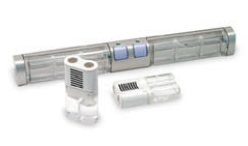
Small-Scale, High-Performance Fuel Cells for Portable Devices: Casio’s fuel cell technology has been officially presented at a chemical engineering conference to be held on March 27, 2002. More than 100 inventions have been made concerning Casio’s fuel cell and the patent applications thereof have been already filed in Japanese Patent Office and other countries. In this compact reformative fuel cell of a super high efficiency, a reformer produces hydrogen from fuel or alcohol such as methanol, and electric energy is generated from the hydrogen through a generating cell. The reformer, so-called a unique micro-reactor formed on a silicon wafer causes chemical reaction to reform methanol to hydrogen gas in the presence of catalyst at a reforming rate of more than 98%. More hydrogen gas indicates more electric energy of the fuel cell. This is the first success in the world in minimizing fuel cell of such high reforming rate. (http://www.casio.co.jp)
Satisfied Eco-Efficiency Elements: Toxicity Reduction, Material Retrieval and Resource Sustainability
#25 Self-Service

Auto Faucet with Self-Powered: TOTO’s aqua auto faucet features a non-contact design that switches on the water flow when the hands are brought near it, and switches off the water when the hands are removed. The absence of handles keeps the area around the basin clean, and the faucet cannot be left running, making it both hygienic and economical. TOTO upgraded the original battery-powered type to a water-powered type. This eliminates the need for installing a power supply or changing batteries, and saves on electricity costs. A flow rate of at least 3L/min is required. Use with in the battery recharging range reduces demand on the special backup battery, and eliminates the need for battery replacement. (http://www.toto.co.jp)
Satisfied Eco-Efficiency Elements: Energy Reduction, Toxicity Reduction and Product Service.
#26 Copying

Virtual Keyboard: VKB has developed a highly efficient method for projecting an optical image of a keyboard onto a surface. Using laser technology, a bright red image of a keyboard is projected from a device such as a handheld. In addition, VKB has developed a detection method through several proprietary developments for the accurate and reliable detection of user interaction, such as typing or cursor control functions (e.g. mouse or touch-pad controls). VKB has resolved all the technological hurdles required to make a practical virtual interface including minimizing the power consumption, minimal component size, simple processing, high accuracy and ease of use. All that is necessary to use the keyboard is a flat surface. (http://www.vkb.co.il)
Satisfied Eco-Efficiency Elements: Material Reduction and Product Service.
#27 An Inexpensive Short-life Object Instead of An Expensive Durable One
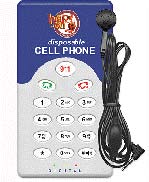
Disposable and Recyclable Cell Phone: Perhaps the most innovative of all the phone’s features is that it’s disposable and recyclable. The price of the phone reflects a competitive calling rate, so there is virtually no investment in the phone itself. When the minutes are used up, you can add more minutes, discard the phone, or return it to Hop-on for an US$5 rebate certificate. Hop-on will melt down the case and recast it, recharge the phone with calling minutes, and send it back out to the marketplace. The process is easy, inexpensive, and environmentally friendly. (http://www.hop-on.com)
Satisfied Eco-Efficiency Elements: Material Reduction, Energy Reduction, Toxicity Reduction and Material Retrieval.
#28 Replacement of a Mechanical System

Vehicle Hybrid System: For reducing environmental impact, Toyota developed new vehicle hybrid system, THSII, to replace traditional petrol engines. The system is low noise, low exhaust pollution and low energy consumption. The system consists two kinds of motive power sources, a high-efficiency gasoline engine that utilizes the Atkinson Cycle, which is a high-expansion ratio cycle, as well as a permanent magnet AC synchronous motor with 1.5 times more output, together with a generator, a hybrid specific high-performance nickel-metal hydride (Ni-MH) battery and a power control unit. This power control unit contains a high-voltage power circuit for raising the voltage of the power supply system for the motor and the generator to a high voltage of 500V, in addition to an AC-DC inverter for converting between the AC current from the motor and the generator and the DC current from the hybrid battery. (http://www.toyota.co.jp)
Satisfied Eco-Efficiency Elements: Energy Reduction and Toxicity Reduction.
#29 Use a Pneumatic or Hydraulic Construction

4-Bag Air Suspension System for Cargo Trucks: Isuzu’s 4-bag air suspension has more longevity and recyclability. As shown as the right picture, the suspension system is composed of (1) V-shaped rod, (2) shock absorber, (3) air spring and (4) stabilizer bar. Now by adopting air-suspension on all axles, rear body vibration is significantly reduced in comparison to vehicles with air-suspension only on rear axles. Low-deck, 4-axle cargo trucks show particular improvement in reducing rear body vibration with full air-suspension. Moreover, both front and rear height adjustment makes loading easier and shortens the loading time. As added benefits, full air-suspension prevents cargo damages and decreases tire wear, thereby reducing insurance costs and saving money. (http://www.isuzu.co.jp)
Satisfied Eco-Efficiency Elements: Product Durability and Product Service.
#30 Flexible Film or Thin Membranes
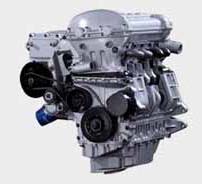
New Conceptual Engine with High Power Output and Low Fuel Consumption: The Saab Variable Compression (SVC) engine is comprised of a cylinder head with integrated cylinders, which is known as the monohead, and a lower portion consisting of the engine block, crankshaft and pistons. The monohead is sealed at the crankcase by a rubber bellows. The compression ratio is varied by adjusting the slope of the upper part of the engine in relation to the lower part by up to four degrees. This alters the volume of the combustion chamber and changes the compression ratio. The SVC engine can be run at the optimum compression ratio of 14:1 at low load and lowered to 8:1 at high load with supercharging (225hp, 224 lb.-ft./1.6L). This concept reduces fuel consumption by up to 30% when compared to a larger conventional NA engine of similar power output. (http://www.saabnet.com)
Satisfied Eco-Efficiency Elements: Energy Reduction, Toxicity Reduction and Product Service.
#31 Use of Porous Material

Watch with Eco-Drive Recharging Function: Citizen Eco-Drive is the best selling light-powered timepiece collection in the world featuring unsurpassed quality and attention to detail. Eco-Drive technology means you never have to replace a battery. Sunlight and any artificial light are absorbed through the crystal and dial. Citizen uses special filters which allow a wide range of dial colors and styles. In fact, the dial is the filter which is a micro-porous structure. The dial plays a critical rule that can make any light passes through it. A solar cell beneath the dial converts any form of light into electrical energy to power the watch. With regular exposure to light, Eco-Drive continuously recharges itself for a lifetime of use. Eco-Drive’s revolutionary lithium-ion rechargeable battery stores enough energy to power the watch for up to an astonishing 5 years, (even in the dark). (http://watch.citizen.co.jp)
Satisfied Eco-Efficiency Elements: Energy Reduction, Toxicity Reduction and Resource Sustainability.
#32 Changing the Color
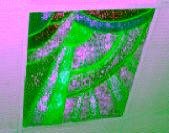
Recyclable Ornamental Glass: The FUH SHAN Company of Taiwan had developed the technique to recycle waste glass. The waste glass can be first gathered and crushed, and then melted and added or changed the color. Finally the colored glass is obtained. The colored glass can be applied to building decoration including floors, walls, mirrors, Chinese screens, etc. Due to varied colors, many beautiful patterns can be made by the colored glass. Furthermore, because the surface of glass has no capillary hole, dust cannot cover the glass, and the color does not fade easily. (http://www.fuh3.com.tw) Satisfied Eco-Efficiency Elements: Material Retrieval and Resource Sustainability.
#33 Homogeneity

Biodegradable Container: The Gabby Technology had developed eco-friendly containers which are made from various natural plant fibers, residues and starch. These containers have the following environmental features: 1. Biodegradable; decomposed completely after 120 hours; will be naturally hydrolyzed as fodder in water; 2. More affordable price than wood-pulping disposable tableware; 3. Heat resistant, water/oil proof, non-toxic, and microwavable; 4. Non-harmful additives used in the manufacturing process. (http://www.gabbytech.com)
Satisfied Eco-Efficiency Elements: Material Retrieval and Resource Sustainability.
#34 Rejecting and Regenerating Parts

Correction Ball Pen with Replaceable Ink: Pentel’s new correction ball pen has a new type replaceable ink. Users just push the upper button and the correction ink would stir automatically. The output of correction ink also adjusts a suitable amount by the correction ball pen itself. Moreover, the diameter of the ball is only 1.00 mm. These functions are convenient and friendly for users. (http://www.pentel.co.jp)
Satisfied Eco-Efficiency Elements: Material Reduction, Product Durability and Product Service.
#35 Transformation of Physical or Chemical States of An Object

Electric Rice Cooker with Variable Pressure Boiling: Sanyo’s new age IH type electric rice cooker with variable pressure boiling can make rice three times sweeter than the early IH type. The rice can expand itself under 1.2 atm and 105 degrees centigrade; simultaneously, the rice in all parts of the container can be cooked thoroughly. Saccharification caused by higher boiling temperature makes the rice has more glucose, therefore the rice tastes sweeter. By the hermetically sealing of the metal layer and mixture layers, the heat energy can be reflected, and therefore it makes the boiling temperature rise to 105 degree centigrade in 1.2 atm. Moreover, this function also can make the cooker reduce electric energy consumption. (http://www.sanyo.co.jp)
Satisfied Eco-Efficiency Elements: Energy Reduction and Product Service.
#36 Phase Transition

Magical Ice Bag Instant Cooling: The Tonghai Home Care Company’s magical ice bag is portable and instant cooling. The magic ice bag contains granular cryogen and an internal bag which holds water. When a user presses the internal bag and the water drains out, then the water and the cryogen cause a chemical reaction. The cryogen can be dissolved and rapidly cool. If the user finishes the use of the magic ice bag, he can place it in the freezer for recyclable use, or makes the cryogen liquid be fertilizer through diluting it with water. (http://www.tonghai.com.tw)
Satisfied Eco-Efficiency Elements: Material Retrieval, Product Durability and Product Service.
#37 Thermal Expansion

Heat-Sinking Rooftop without Energy Consumption: In summer, the inside air temperature of a factory is always higher than the outside air temperature. This condition does not make the employees comfortable. The Tech-Way Company, which comes from Taiwan, had developed the heat-sinking rooftop to resolve the problem. Due to heat convection and thermal expansion of air, the hot air first enters into the gaps, and then climbs and passes through the channel between the upper rooftop and the lower rooftop, finally exits from the heat-sinking gaps. All the actions do not need energy consumption, and can make the interior of the factory nice and cool. This technique had been introduced into many factories in Taiwan. (http://www.tech-way.com.tw)
Satisfied Eco-Efficiency Element: Energy Reduction.
#38 Use Strong Oxidizers
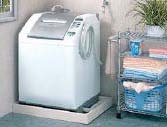
Electrolyzed Water Cleaning Powered Washing Machine: Sanyo achieved the world’s first electrolyzed water powered “non-detergent course†washing machine. Perfect for cleaning everyday cloths washed just because they have been worn. The “Washing with Ultrasonic Waves and Electrolysis†washing machine uses electrolyzed water power produced using electrodes placed on the side of the wash basin that produce active oxygen and hypochlorous acid that work to dissolve organic dirt such as sweat on items like bath towels, undershirts, pajamas, and T-shirts etc. Electrolyzed water combined with the ultrasonic waves provides all the cleansing power with no detergent. (http://www.sanyo.co.jp)
Satisfied Eco-Efficiency Elements: Toxicity Reduction and Resource Sustainability.
#39 Inert Environment

Heat Insulation Paint: Shin Diing Painting Company has developed a new paint which can insulate heat transfer. The heat insulation paint contains many vacuum capsules. After painting on the roof of a building, it may be likened to constructing a heat insulation layer on the roof. Through proof, the room temperature can be reduced 5 to 7 degrees centigrade, and the internal surface temperature can be decreased 20 degrees centigrade or more. The heat insulation results in reduction of air conditioner energy consumption. (http://5168.t886.com)
Satisfied Eco-Efficiency Element: Energy Reduction.
#40 Composite Materials

Long-Life Building Material: Misawa had developed a novel long-life building materials ‘M-Wood’ for environmental consciousness. M-Wood can almost replace all traditional wood building materials. M-Wood is made as the flowchart as the right picture: The waste of conifer from works is gathered and crushed to powder; next added resin to synthesize the “M-Wood Raw Powderâ€; then the “M-Wood Raw Powder†can be made all styles of building materials. M-Wood is very like real wood including color and grain; furthermore, its strength and durability are much higher. Misawa had constructed many “Green Buildings†with M-Wood in Japan. Now the new product “M-Wood2†has been presented, which has higher performance in practice and recycling. (http://www.misawa.co.jp)
Satisfied Eco-Efficiency Elements: Material Retrieval, Resource Sustainability, Product Durability and Product Service.
Conclusions
The above-mentioned examples are successfully matched with 40 TRIZ inventive principles. These product examples demonstrated the applicability of the 40 TRIZ inventive principles for eco-innovative design tasks. All these examples are collected in our computer aided design software “Eco-Design Toolâ€. This software that integrates the eco-innovative ideas with TRIZ can assist design engineers to develop new products more efficiently. “Eco-Design Tool†still keeps modifying and updating. More examples will be stored up in this software.
Due to troublesome design tasks or insufficient experience, design engineers may not easily solve the conflict problem. These proposed practical examples are conducive to inspire design engineers for developing eco-innovative products. If readers have any comment or question about this paper, please contact with the corresponding author.
Acknowledgements
This work is supported by the National Science Council, Taiwan; under grant numbers, NSC89-2212-E006-169 and NSC90-2212-E006-102.
References
1. Hsu M -Y Promoting innovation for environment by green patent system Proceedings of International Conference on Cleaner Production and Sustainable Development’99 December 13-17 Taipei, Taiwan, (1999) pp 485-494
2. Low M K, Lamvik T, Walsh K, and Myklebust O Product to service eco-innovation: the TRIZ model of creativity explored Proceedings of International Symposium on Electronics and the Environment, IEEE, San Francisco, California, May 8-10, (2000) pp 209-214
3. Jones E and Harrison D Investigating the use of TRIZ in eco-innovation The TRIZ Journal (2000) September https://the-trizjournal.com
4. Mann D and Jones E Sustainable services & systems through systematic innovation methods towards sustainable product design, 6th International Conference, October, 29-30, Amsterdam, Netherlands, (2001)
5. Jones E, Harrison D, and Stanton N A The application of TRIZ tools in an eco-innovation process Proceedings of World Conference on TRIZ Future 2001, November 7-9, Bath, UK, (2001) pp 57-78
6. Liu C -C and Chen J L Development of product green innovation design method Proceedings of EcoDesign 2001: Second International Symposium on Environmentally Conscious Design and Inverse Manufacturing, December 11-15, Tokyo, Japan, (2001) pp 168-173
7. Liu C -C and Chen J L A TRIZ inventive product design method without contradiction information The TRIZ Journal (2001) September https://the-trizjournal.com
8. Chen J L and Liu C -C An eco-innovative design approach incorporating the TRIZ method without contradiction analysis, to appear in the Journal of Sustainable Product Design (2003)
9. Chen J L and Liu C -C Green innovation design of products by TRIZ inventive principles and green evolution rules, 2002 International CIRP Design Seminar, May 16-18, Hong Kong (2002)
10. Chen J L Green evolution rules and ideality laws for green innovative design of products, CARE INNOVATION 2002, November 25-28, Vienna, (2002)
11. Desimone L D and Popoff F Eco-efficiency: The Business Link to Sustainable Development Massachusetts Institute of Technology (1997)
12. Mann D and Domb E 40 inventive (business) principles with examples The TRIZ Journal (1999) September https://the-trizjournal.com
13. Terninko J 40 inventive principles with social examples The TRIZ Journal (2001) June
14. Mann D and Catháin C Ó 40 inventive (architecture) principles with examples The TRIZ Journal (2001)
July https://the-trizjournal.com
15. Rea K C TRIZ and software – 40 principle analogies, part 1 The TRIZ Journal (2001) September
16. Rea K C TRIZ and software – 40 principle analogies, part 2 The TRIZ Journal (2001) November
17. Mann D and Winkless B 40 inventive (food) principles with examples The TRIZ Journal (2001) October
18. Retseptor G 40 inventive principles in microelectronics The TRIZ Journal (2002) August

